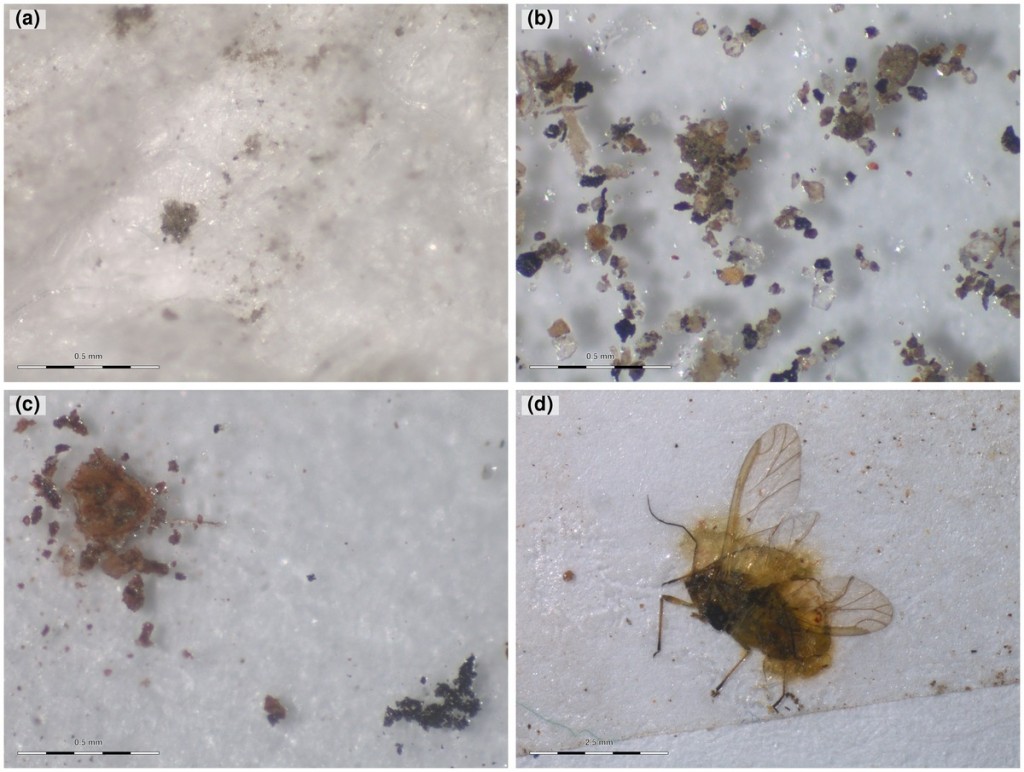12 June 2012
Citizen-scientists answer call for Icelandic volcano ash samples
Posted by kramsayer

Citizen-scientists from the United Kingdom sent in 130 sticky-tape samples, allowing scientists to track tephra from an Icelandic volcano. In addition to tephra,(a), they also collected sand (b), "industrial gunk" (c), and "organic contaminants" (d), said volcanologist John Stevenson. (Credit: Stevenson)
GeoSpace is in Selfoss, Iceland this week, reporting from AGU’s Chapman Conference on Volcanism and the Atmosphere. Check back for posts on the science presented at the meeting, as well as field trips to nearby volcanoes and geologic features.
Selfoss, Iceland – When Iceland’s Grímsvötn volcano erupted in May 2011, ejecting 0.7 cubic kilometers (0.2 cubic miles) of ash far up into the atmosphere, most of the material headed north to the pole. But some of the ejected ash stayed a little closer to the ground – about 4 km (2.5 miles) up – and drifted southeast in a plume headed right over Scotland.
Computer models predicted the path of the plume, satellites beamed back images, but one researcher turned to a low-tech and inexpensive method of tracking the ash fall – cellophane sticky tape.
In a citizen-science effort coordinated by the British Geological Survey, John Stevenson of Edinburgh University in the United Kingdom studied where ash actually fell, the sizes of the ash grains, and the timing of the plume’s arrival.
“We put out a video on YouTube, which had instructions on how to collect the tephra,” Stevenson said. He presented the research Monday at the AGU-sponsored Chapman Conference on Volcanism and the Atmosphere in Selfoss, Iceland.
The videos showed people how to place a length of clear tape outdoors, sticky side up, during the ash fall, and then attach it to a clean, white sheet of paper. The geologists asked people to send in those samples along with the time they put the tape out and when they brought it back in – and then Stevenson and his colleagues could examine the samples under a microscope.
“The grains are pretty small, but you get a few of them,” Stevenson said. With these makeshift slides, researchers identified what stuck to the tape – everything from sand to pollution to winged bugs, but also ash.
“We got great coverage of the entire UK,” he said, noting that 130 samples were sent in. When they examined the tape for the ash, which often just looked like a smudge the particles were so small, they found it on a number of samples – which mostly came from Scotland on May 24, the day models predicted the plume would arrive.
Stevenson also looked at pollen filters set up across the UK, where he found ash grains arranged in tiny rings stuck to the filters, marking where tephra-filled raindrops had been caught. In analyzing some of the rainwater that fell between 23 and 24 May, the geologists found ash particles that were about 25 microns in diameter, but also ranged up to 80 microns. While that’s big for a grain of ash, it’s still so small that if you rubbed particles between your thumb and forefinger, you would barely sense them, he said.
With additional data from instruments designed to measure pollution, the scientists had a range of observations of the tephra plume in hand to compare with computer model predictions. In general the two methods agreed, Stevenson said – the model had the plume reaching Scotland on 24 May. The observational methods, however, are not optimal for measuring the quantity of ash, he added.
One thing the research does point out, though, is the fact that relatively large ash grains can travel in the plume – it’s not just the fine ash. So when researchers attach sampling devices to airplanes or drones, or set out standard pollution measuring equipment to catch ash grains, he said, they should ensure that the tools can also catch bigger chunks of tephra as well to create better plume forecasts and models.
“Big grains from small plumes can still travel long distances,” Stevenson said.
-Kate Ramsayer, AGU science writer










 GeoSpace is a blog on Earth and space science, managed by AGU’s Public Information staff. The blog features posts by AGU writers and guest contributors on all sorts of relevant science topics, but with a focus on new research and geo and space sciences-related stories that are currently in the news.
GeoSpace is a blog on Earth and space science, managed by AGU’s Public Information staff. The blog features posts by AGU writers and guest contributors on all sorts of relevant science topics, but with a focus on new research and geo and space sciences-related stories that are currently in the news.